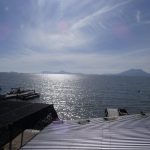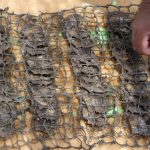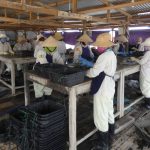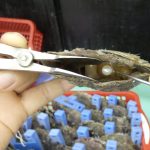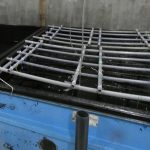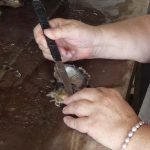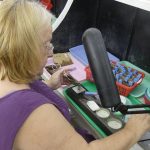I’m just back from an amazing working visit to an akoya pearl farm in Vietnam.
I spent three days at the farm so I can now describe for you the process for growing akoya pearls. Firstly it is similar to the process for south sea pearls.
Let’s start at the beginning:
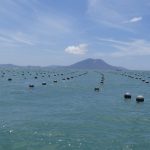
These are the visible manifestation of the farm – the lines of buoys marking the suspended baskets of pearls, busily feeding, excreting, making pearls
All the oysters spend their adult life out at sea. They like nice, warm (23-29degrees C) water, just the right salinity, just tidal enough to bring in lots of lovely delicious plankton and sweep away their excreta.
I am always amazed at how the boat crews manage to find their way around the farm and find exactly the oysters they seek – to me it seems a confusing and anonymous maze of black buoys
When time comes for harvest the long baskets are collected and taken ashore, where the oysters are taken out of the baskets. The oysters will have been in the open sea for between a few months for the ones with four 1.3mm nuclei (this pearl farm is thought to be the only farm in the world producing such tiny pearls) to closer to a year for what will be 7mm up round classic pearls
Those which look the healthiest at first blush are selected out for special opening while most will be opened and the pearls removed, either by hand,
or for small pearls, in a process which (rather unromantically but very practically) reduces the flesh to a mush and allows the pearls to fall to the bottom of a large cement mixer type
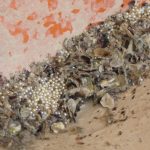
the ‘Cement mixer’ after the washing process – only random bits of shell and the tiny 1.5mm akoya pearls remain
machine.
The farm I visited produces pearls from 7mm down to a minute 1.5mm in a range of colours from white to gold and shades of blue and violet to purple
Some of the oysters are selected out at this stage as possible donors. These shells will be more carefully opened and the pearl inside extracted carefully. It will be scrutinised for quality and size – colour, lustre, clean surface and is it over 7mm. The oysters which have produced such pearls are used to provide donor mantle tissue for the next generation. The obvious flaw to this is that, of course, the donor tissue inside the oyster which has produced the pearl is not related (except distantly) to this specific oyster, but it is reckoned – practically – that a pearl is 80% donor mantle and 20% host. And this process looks for the best and healthiest hosts – and thus to optimise the general stock on the farm. While the donor tissue secretes the pearl it is the host which keeps the donor tissue alive.
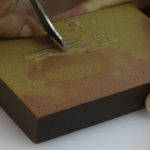
1mm pieces of selected mantle tissue – the tissue which secretes nacre – being prepared for implanting
The farm has its own hatchery – more and more farms are establishing hatcheries to ensure strong and selected stock rather than rely on wild spat. New stock is bred from selected oysters, reared in carefully clean conditions. Everyone at the farm washes hands, removes shoes and washes feet and some wear masks to work in the hatchery. New-born larvae are free swimming, then at 10 days the microscopically small oysters become spats and grab onto helpful ropes to grow on.
And finally, they let me not only open some oysters and harvest the pearls (I was surprised at how soft and easily cut through the shells are) but sit and assess for mantle tissue donors – awesome responsibility.
Thanks to Orient Pearl for their invitation and hospitality
